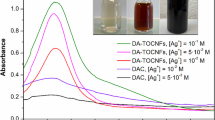Abstract
The aim of the study is to examine thermal behavior of water within reticulated structure of bacterial cellulose (BC) films by sub-ambient differential scanning calorimetry (DSC). BC films with different carbon source, either manitol (BC (a)) or glycerol (BC (b)), were produced by Acetobacter xylinum using Hestrin and Shramm culture medium under static condition at 30 ± 0.2°C for 3 days. BC samples were characterized by electron scanning microscopy and X-ray diffraction spectroscopy. The pore analysis was done by B.H.J. nitrogen adsorption. The pre-treated with 100% relative humidity, at 30.0 ± 0.2°C for 7 days samples were subjected to a between 25 and −150°C-cooling–heating cycle of DSC at 5.00°C/min rate. The pre-treated samples were also hydrated by adding 1 μl of water and thermally run with identical conditions. It is observed that cellulose fibrils of BC (a) were thinner and reticulated to form slightly smaller porosity than those of BC (b). They exhibited slightly but non-significantly different crystalline features. The freezable bound water behaved as a water confinement within pores rather than a solvent of polymer which is possible to use thermoporosimetry based on Gibb–Thomson equation to approach pore structure of BC. In comparison with nitrogen adsorption, it was found that thermoporosimetry underestimated the BC porosity, i.e., the mean diameters of 23.0 nm vs. 27.8 nm and 27.9 nm vs. 33.9 nm for BC (a) and BC (b), respectively, by thermoporosimetry vs. B.H.J. nitrogen adsorption. It may be due to large non-freezable water fraction interacting with cellulose, and the validity of pore range based on thermodynamic assumptions of Gibb–Thomson theory.





Similar content being viewed by others
References
H. S. Barud et al. Thermal characterization of bacterial cellulose–phosphate composite membranes. J. Therm. Anal. Calorim. 87:815–818 (2007).
K. Watanabe, M. Tabuchi, Y. Morinaga, and F. Yoshinaga. Structural features and properties of bacterial cellulose produced in agitated culture. Cellulose. 5:187–200 (1998).
D. Klemm, D. Schumann, U. Udhardt, and S. Marsch. Bacterial synthesized cellulose—artificial blood vessels for microsurgery. Prog. Polym. Sci. 26:1561–1603 (2001).
T. Maneerung, S. Tokura, and R. Rujiravanit. Impregnation of silver nanoparticles into bacterial cellulose for antimicrobial wound dressing. Carbohyd. Polym. 72:43–51 (2008).
G. Zografi, and M. J. Kontny. The interactions of water with cellulose- and starch-derived pharmaceutical excipients. Pharm. Res. 3:187–194 (1986).
D. Faroongsarng, and P. Sukonrat. Thermal behavior of water in the selected starch- and cellulose-based polymeric hydrogel. Int. J. Pharm. 352:152–158 (2008).
P. Luukkonen, T. Maloney, J. Rantanen, H. Paulapuro, and J. Yliruusi. Microcrystalline cellulose–water interaction—a novel approach using thermoporosimetry. Pharm. Res. 18:1562–1569 (2001).
K. Gelin, A. Bodin, P. Gatenholm, A. Mihranyan, K. Edwards, and M. Strømme. Characterization of water in bacterial cellulose using dielectric spectroscopy and electron microscopy. Polym. 48:7623–7631 (2007).
S. Hestrin, and M. Schramm. Synthesis of cellulose by Acetobacter xylinum: preparation of freeze dried cells capable of polymerizing glucose to cellulose. Biotechnol. J. 58:345–352 (1954).
K. Sansernluk, S. Kaewnopparat, and D. Faroongsarng. Properties of bacterial cellulose produced by Acetobacter xylinum TISTR975 from different sugars and preparation of bacterial cellulose containing nanosilver. Proceedings 7th National Graduate Research Conference, Prince of Songkla University, Surat Thani, Thailand, 2007.
K. Nagamura, T. Hatakeyama, and H. Hatakeyama. Studies on bound water of cellulose by differential scanning calorimetry. Tex. Res. J. 51:607–613 (1981).
V. D. Aleksandov, and O. V. Sobol’. Comparison between superheating of crystals in melting and supercooling of melts in crystallization. Russ. J. Phys. Chem. 81:2100–2103 (2007).
M. R. Landry. Thermoporosimetry by differential scanning calorimetry: experimental considerations and applications. Thermochim. Acta. 433:27–50 (2005).
R. Neffati, L. Apekis, and J. Rault. Size distribution of water droplets in butyl rubber: application of DSC in thermoporosimetry. J. Therm. Anal. Calorim. 54:741–752 (1998).
K. Ishikiriyama et al. Pore size distribution measurements of polymer hydrogel membranes for artificial kidneys using differential scanning calorimetry. Thermochim. Acta. 267:169–180 (1995).
S. Park, R. A. Vanditti, H. Jameel, and J. J. Pawlak. Changes in pore size distribution during the drying of cellulose fibers as measured by differential scanning calorimetry. Carbohyd. Polym. 66:97–103 (2006).
J.-M. Nedelec, J.-P. E. Grolier, and M. Baba. Thermoporosimetry: a powerful tool to study the cross-linking in gels networks. J. Sol-Gel Sci. Techn. 40:191–200 (2006).
S. Ozeki. Dielectric properties of water adsorbed in slitlike micropores of jarosite. Langmuir. 5:181–186 (1989).
K. Isikiriyama, and M. Todoki. Pore size distribution measurements of silica gels by means of differential scanning calorimetry. J. Colloid Interf. Sci. 171:103–111 (1995).
F. P. Cuperus, D. Bargeman, and C. A. Smolders. Critical points in the analysis of membrane pore structures by thermoporosimetry. J. Memb. Sci. 66:45–53 (1992).
C. T. Maloney, H. Paulapurpo, and P. Stenius. Hydration and swelling of pulp fibers measured with differential scanning calorimetry. Nord. Pulp Pap. Res. 13:31–36 (1998).
Acknowledgements
The authors would like to thank Prince of Songkla University, Thailand Research Fund, and Commission on Higher Education for financial support. Special thanks also go to the Scientific Equipment Center, the Department of Pharmaceutical Technology, and the Department of Chemical Engineering for providing the lab facilities.
Author information
Authors and Affiliations
Corresponding author
Rights and permissions
About this article
Cite this article
Kaewnopparat, S., Sansernluk, K. & Faroongsarng, D. Behavior of Freezable Bound Water in the Bacterial Cellulose Produced by Acetobacter xylinum: An Approach Using Thermoporosimetry. AAPS PharmSciTech 9, 701–707 (2008). https://doi.org/10.1208/s12249-008-9104-2
Received:
Accepted:
Published:
Issue Date:
DOI: https://doi.org/10.1208/s12249-008-9104-2




